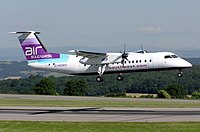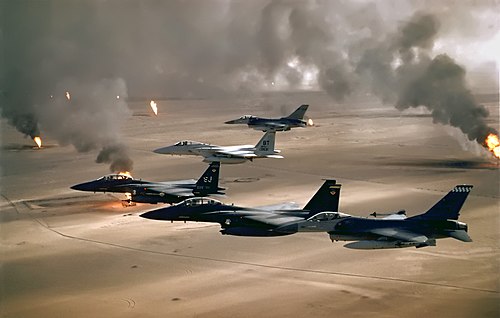Portal:Aviation
| Main page | Categories & Main topics |
|
Tasks and Projects |
The Aviation Portal

Aviation includes the activities surrounding mechanical flight and the aircraft industry. Aircraft includes fixed-wing and rotary-wing types, morphable wings, wing-less lifting bodies, as well as lighter-than-air craft such as hot air balloons and airships.
Aviation began in the 18th century with the development of the hot air balloon, an apparatus capable of atmospheric displacement through buoyancy. Some of the most significant advancements in aviation technology came with the controlled gliding flying of Otto Lilienthal in 1896; then a large step in significance came with the construction of the first powered airplane by the Wright brothers in the early 1900s. Since that time, aviation has been technologically revolutionized by the introduction of the jet which permitted a major form of transport throughout the world. (Full article...)
Selected article
Selected image
Did you know
...that Alejandro Maclean, Spanish television producer and Red Bull Air Race World Series pilot, is nicknamed "The Flying Matador"? ...that Indra Lal Roy of the Royal Air Force became India's first flying ace after he achieved 10 victories in thirteen days during World War I? ... that Wing Commander John Lerew, ordered to defend Rabaul against Japanese invasion in 1942, signaled headquarters the legendary gladiatorial phrase "We who are about to die salute you"?
General images -
In the news
- May 29: Austrian Airlines cancels Moscow-bound flight after Russia refuses a reroute outside Belarusian airspace
- August 8: Passenger flight crashes upon landing at Calicut airport in India
- June 4: Power firm helicopter strikes cables, crashes near Fairfield, California
- January 29: Former basketball player Kobe Bryant dies in helicopter crash, aged 41
- January 13: Iran admits downing Ukrainian jet, cites 'human error'
- January 10: Fire erupts in parking structure at Sola Airport, Norway
- October 27: US announces restrictions on flying to Cuba
- October 3: World War II era plane crashes in Connecticut, US, killing at least seven
- September 10: Nevada prop plane crash near Las Vegas leaves two dead, three injured
- August 6: French inventor Franky Zapata successfully crosses English Channel on jet-powered hoverboard
Related portals
Associated Wikimedia
The following Wikimedia Foundation sister projects provide more on this subject:
-
Commons
Free media repository -
Wikibooks
Free textbooks and manuals -
Wikidata
Free knowledge base -
Wikinews
Free-content news -
Wikiquote
Collection of quotations -
Wikisource
Free-content library -
Wikiversity
Free learning tools -
Wikivoyage
Free travel guide -
Wiktionary
Dictionary and thesaurus
Selected biography
By 1919 Earhart had enrolled at Columbia University to study pre-med but quit a year later to be with her parents in California. Later in Long Beach she and her father went to a stunt-flying exhibition and the next day she went on a ten minute flight.
Earhart had her first flying lesson at Kinner Field near Long Beach. Her teacher was Anita Snook, a pioneer female aviator. Six months later Earhart purchased a yellow Kinner Airster biplane which she named "Canary". On October 22, 1922, she flew it to an altitude of 14,000 feet, setting a women's world record.
After Charles Lindbergh's solo flight across the Atlantic in 1927, Amy Guest, a wealthy American living in London, England expressed interest in being the first woman to fly (or be flown) across the Atlantic Ocean, but after deciding the trip was too dangerous to make herself, she offered to sponsor the project, suggesting they find "another girl with the right image." While at work one afternoon in April 1928 Earhart got a phone call from a man who asked her, "Would you like to fly the Atlantic?"
Selected Aircraft

The de Havilland Canada DHC-8, popularly the Dash 8, is a series of twin-turboprop airliners designed by de Havilland Canada in the early 1980s. They are now made by Bombardier Aerospace which purchased DHC from Boeing in 1992. Since 1996 the aircraft have been known as the Q Series, for "quiet", due to installation of the Active Noise and Vibration Suppression (ANVS) system designed to reduce cabin noise and vibration levels to near those of jet airliners.
Notable features of the Dash 8 design are the large T-tail intended to keep the tail free of propwash during takeoff, a very high aspect ratio wing, the elongated engine nacelles also holding the rearward-folding landing gear, and the pointed nose profile. First flight was in 1983, and the plane entered service in 1984 with NorOntair. Piedmont Airlines (formerly Henson Airlines) was the US launch customer for the Dash 8 in 1984.
The Dash 8 design had better cruise performance than the earlier Dash 7, was less expensive to operate, and more notably, much less expensive to maintain. The Dash 8 had the lowest costs per passenger mile of any feederliner of the era. The only disadvantage compared to the earlier Dash 7 was somewhat higher noise levels, but only in comparison as the Dash 7 was notable in the industry for extremely low noise due to its four very large and slow-turning propellers.
- Length: 107 ft 9 in (32.84 m)
- Wingspan: 93 ft 3 in (32.84 m)
- Height: 27 ft 5 in (8.34 m)
- Powerplant: 2× Pratt & Whitney Canada PW150A turboprops, 5,071 shp (3,781 kW) each
- Cruise speed: 360 knots (414 mph, 667 km/h)
- Maiden Flight: June 20, 1983
Today in Aviation
- 2011 – A CASA C-212 Aviocar of the Chilean Air Force crashed into the sea off Robinson Crusoe Island. All 21 people on board were killed.
- 2009 – Andhra Pradesh Chief Minister helicopter crash: A Bell 430 helicopter crashes at Rudrakonda Hill, India, killing all five people on board, including Y. S. Rajasekhara Reddy, Chief Minister of Andhra Pradesh.
- 2008 – ExpressJet Airlines ended operations as an independent carrier.
- 2006 – A Royal Air Force Hawker-Siddeley Nimrod MR.2 NATO reconnaissance plane, XV230, crashes near Kandahar, Afghanistan after a fire and explosion caused by a fuel leak. All 14 crew on board are killed.
- 2003 – A soldier is killed as a UH-60L Black Hawk from 2–501st Aviation Regiment rolls over during a nighttime troop insertion southwest of Baghdad.[1]
- 1998 – Swissair Flight 111, a McDonnell Douglas MD-11, crashes into the sea near Halifax, Nova Scotia in Canada, because of an onboard fire. All 229 people on board perish.
- 1998 – First flight of the Boeing 717
- 1998 – A Permaviatrans Antonov An-26 was shot down by UNITA rebels over Angola. All 24 people on board were killed.
- 1995 – RAF Kinloss Wing Hawker Siddeley Nimrod MR.2, XV239, crashes into Lake Ontario, at Toronto, Canada, during the 46th Canadian National Exhibition International airshow, killing all seven crew of 120 Squadron. Video of this crash is widely available on the internet.
- 1990 – The number of U. S. Air Force aircraft deployed in and around Saudi Arabia has risen to 400 combat and 200 support aircraft.
- 1986 – Schweizer RG-8A, 85-0048, c/n 4, ex-civil registration N3623C, modified Schweizer SGS 2-32 motor glider for U.S. Army Grisly Hunter reconnaissance project. Crashed at Ft. Huachuca, Arizona, killing two-man crew.
- 1981 – Two Italian Air Force Fiat G.91PANs of the Frecce Tricolori collide over Rivolto during a team practice, team leader is killed.
- 1975 – The unified Canadian Armed Forces merges its aviation services into a single command, the Canadian Forces Air Command.
- 1966 – A USN Grumman F-11A Tiger, BuNo 141764, of the Blue Angels aerobatic team, Blue Angel 5, crashes on the shore of Lake Ontario during the International Air Exhibition at Toronto, Canada. The pilot, Lieutenant Commander Richard "Dick" Oliver, 31 years old, of Fort Mill, South Carolina, is killed. Coming out of a knife edge pass, followed by a roll, 5 contacts the lake surface at ~500 mph and literally skis across the surface, striking a six-foot high sheet steel piling retaining wall on the edge of Toronto Island Airport and disintegrating. Wreckage (turbine) is thrown as far as 3,483.6 feet from point of initial impact.
- 1958 – The 1958 London Vickers Viking accident occurred near Southall, London, killing all 3 crew on board and another 4 people on the ground.
- 1949 – First flight of the De Havilland Venom
- 1948 – The 1948 Lutana crash; Australian National Airways Flight 331, a Douglas DC-3, crashes into high terrain near Nundle, New South Wales, killing all 13 people on board.
- 1947 – S/L CN Burridge and crew of the RCAF high speed rescue launch ‘Takuli’, completed a 7000 mile voyage from Patricia Bay, BC to Dartmouth Nova Scotia, via the Panama Canal.
- 1947 – First flight of the Hawker P.1040 VP401
- 1945 – At the conclusion of the surrender ceremony aboard the U. S. Navy battleship USS Missouri (BB-63) in Tokyo Bay, in which Japan formally surrenders to the Allies to end World War II, 450 Allied carrier planes and several hundred U. S. Army Air Forces aircraft perform a victory fly-by over the ships in the bay.
- 1944 – In an experiment with the use of the F4U Corsair as a fighter-bomber, Charles Lindbergh—the first man to fly solo across the Atlantic Ocean—flies a bombing mission in an F4U as a civilian consultant with United Aircraft, dropping one 2,000-lb (907-kg) and two 1,000-pound (454-kg) bombs on Japanese positions in the Marshall Islands.
- 1943 – U. S. Army Fifth Air Force aircraft attack the airfield and harbor at Wewak, New Guinea, sinking two Japanese merchant ships.
- 1942 – The only test flight of the Soviet Antonov A-40 winged tank is partially successful. Although A-40′s aerodynamic drag forces the Tupolev TB-3 towing it to detach it early to avoid crashing, the A-40 glides to a successful landing and drives back to base as a conventional T-60 tank. The A-40 project nonetheless is abandoned due to the lack of aircraft powerful enough to tow it.
- 1942 – First flight of the Hawker Tempest
- 1941 – First RCAF night fighter victory was scored by F/O RC Fumerton and Sgt LPS Bing in a Bristol Beaufighter of 406 Squadron, over Bedlington, England.
- 1940 – Aircraft from the British aircraft carrier HMS Ark Royal conduct Operation Smash, a night raid on Cagliari, Sardinia. While some Swordfish drop parachute flares, others bomb an Italian military headquarters and aircraft parked on the ground.
- 1939 – First flight of the Messerschmitt Me 210
- 1939 – In anticipation of war breaking out with Germany, the Royal Air Force’s Advanced Air Striking Force deploys to bases around Rheims, France.
- 1937 – First flight of the Grumman F4F Wildcat
- 1930 – The first nonstop airplane flight from Europe to the United States was completed in 37 hours as Capt. Dieudonne Costes and Maurice Bellonte of France arrived in Valley Stream, N. Y., aboard a Breguet biplane. (The plane was known as “The Question Mark” because it bore the image of the punctuation sign on its side.)
- 1925 – The U. S. zeppelin the USS Shenandoah crashes, killing 14.
- 1910 – Blanche Stuart Scott makes the first solo airplane flight by a woman in the United States subsequently recognized by the Early Birds of Aviation.
- 1891 – The first parachute descent by a Canadian woman was made when Nellie Lamount jumped from a hot-air balloon during a fair in Quebec.
- 1858 – Samuel King introduces the first dragline in America. It is a long rope attached to the basket, which helps to stabilize altitude by dragging on the ground when the balloon is flying very low.
References
- Shortcuts to this page: Portal:Airplanes • P:AVIA





















































